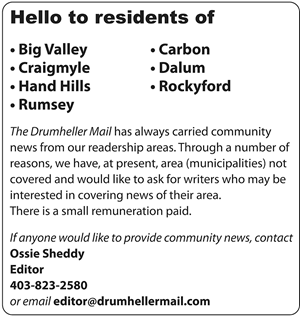
Members of the Alberta Utilities Commission (AUC), Hand Hills Landowner Group (HHLG), and BluEarth Renewables (BER) took part in a two-day public hearing via Zoom, on September 17 and 18, regarding amendments to the previously approved Hand Hills Wind Project.
The project was previously approved in 2013 with ongoing data and development since. In an amended application submitted by BER in February 2020, the company requested to increase the project’s overall capacity from 78.2 megawatts to 130 megawatts, and reduce the number of wind turbines from 34 to 29.
Director of project development for BER, Gareth McDonald said during the hearing, “The project will provide clean, renewable energy for approximately 65,000 homes annually.”
He added the electricity produced would “offset approximately 250,000 tonnes of carbon dioxide emissions per year.”
Projections indicate the wind farm could bring direct investment of an estimated $250 million to the provincial and local economies, and tax revenue “over $850,000 per year” without increasing demand on local services such as sewer and water.
Despite projected advantages, the HHLG voiced a number of concerns the wind farm could have on the Hand Hills ecological area.
Two landowners, who have property bordering the proposed wind farm, offered testimony.
Kelly Fitzpatrick owns a more than century-old farm on the northern border of the wind farm. She noted the proposed site includes five special bird areas which are home to migratory birds throughout the year, and is concerned disturbances could impact the migratory patterns of birds and other animals in the area.
“Right now on our farm there are thousands and thousands upon thousands [sic] of geese flying over this area,” she stated during her testimony.
There are also concerns for the nesting and breeding grounds of the sharp-tailed grouse, and the risks turbines could pose to the endangered little brown bat population.
A 2016 study by the Journal of Wildlife Management estimates wind turbines kill approximately 70,000 bats per year in Canada. While mortalities are mostly related to migratory bat species, the study found little brown bats “accounts for 13 per cent of all mortalities from wind turbines,” with more than 85 per cent of those being in Ontario.
Jo-Lynn Melin also owns property near the proposed site. She purchased the property earlier this year with intentions to retire and create a “Bed and Bale” resort.
The resort would allow people to overnight on Melin’s property and go horseback riding into the Hand Hills. Melin said the bed and bale would also “work hand in hand” with her other retirement project: a horse breeding operation.
“The truth of the matter is, nobody wants to ride around wind turbines,” Melin said during her testimony. “I can promise you that as broke and well-mannered as my horses are, I could not ride them around those turbines.”
Melin noted health impacts, to both herself and her animals, and other income losses from aborted or stillborn foals were also worrisome for her.
“I didn’t buy this property with the intention of reselling and relocating,” Melin said. “This was to be my retirement home, and to provide me with retirement income.”
Traffic increases, noise and light pollution, and impacts to the area’s water table were other concerns brought up by the HHLG witnesses.
Melin and Fitzpatrick also noted the pristine, unaltered landscape of the Hand Hills would be marred by the turbines. Fitzpatrick alone would have approximately 10 turbines within a direct line of sight from her property.
Decision on the Hand Hills Wind Project was deferred to allow time for written argument and reply to be submitted by all parties involved.
A decision is expected before January 2021.

















